Glass Shells
The superficial resemblance of the Swiss Re tower by Foster and the Agbar tower by Nouvel conceals different ways of conceiving high-rise construction.
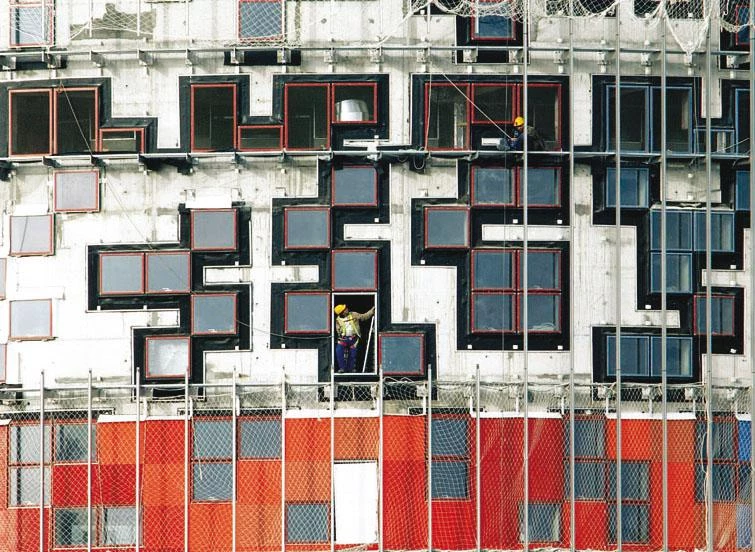
They look similar, and in truth are worlds apart. Erect and streamlined, the Swiss Re and Agbar towers seem to soften the mineral frigidness of their glass skins with their roundness, letting the wind or the gaze of the pedestrian slide along their surfaces and adapting their domed summits to symbolic penetrations in fluids or orifices. But in internal organization these crystal totems are rigorously antithetical, and whereas Norman Foster’s skyscraper in London’s City uses the regular structure of the flower, pineapple or corncob, Jean Nouvel’s in Barcelona’s Plaza de las Glorias adopts the displaced arrangement of a vertebrate’s trunk: while the tower of the insurance company Swiss Re evokes the implacable geometry of plant architec-tures, that of the Compañía de Aguas de Barcelona protects with its randomly perforated exoskeleton the uneven section of animal anatomies. Foster’s work is a geodesic bubble of glass and steel, stretched to the shape of a vertical zeppelin; Nouvel’s is a cylindrical bunker of concrete coated with aluminum and glass, extended by extrusion to itsparabolical tip. And if the London cigar divides its interior into floors of six petals and triangular courtyards along the facade that coil in an eddy around a stalk or central core, the Barcelona missile situates its spinal column of vertical communications in an off-center position that shifts the work zones to the area of the thorax organs or the white of the egg whose section it imitates.
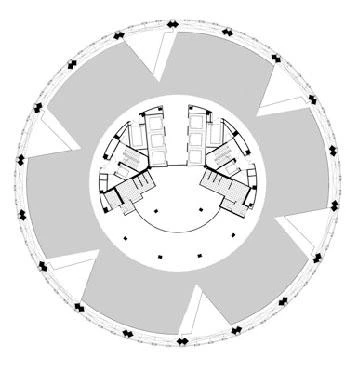
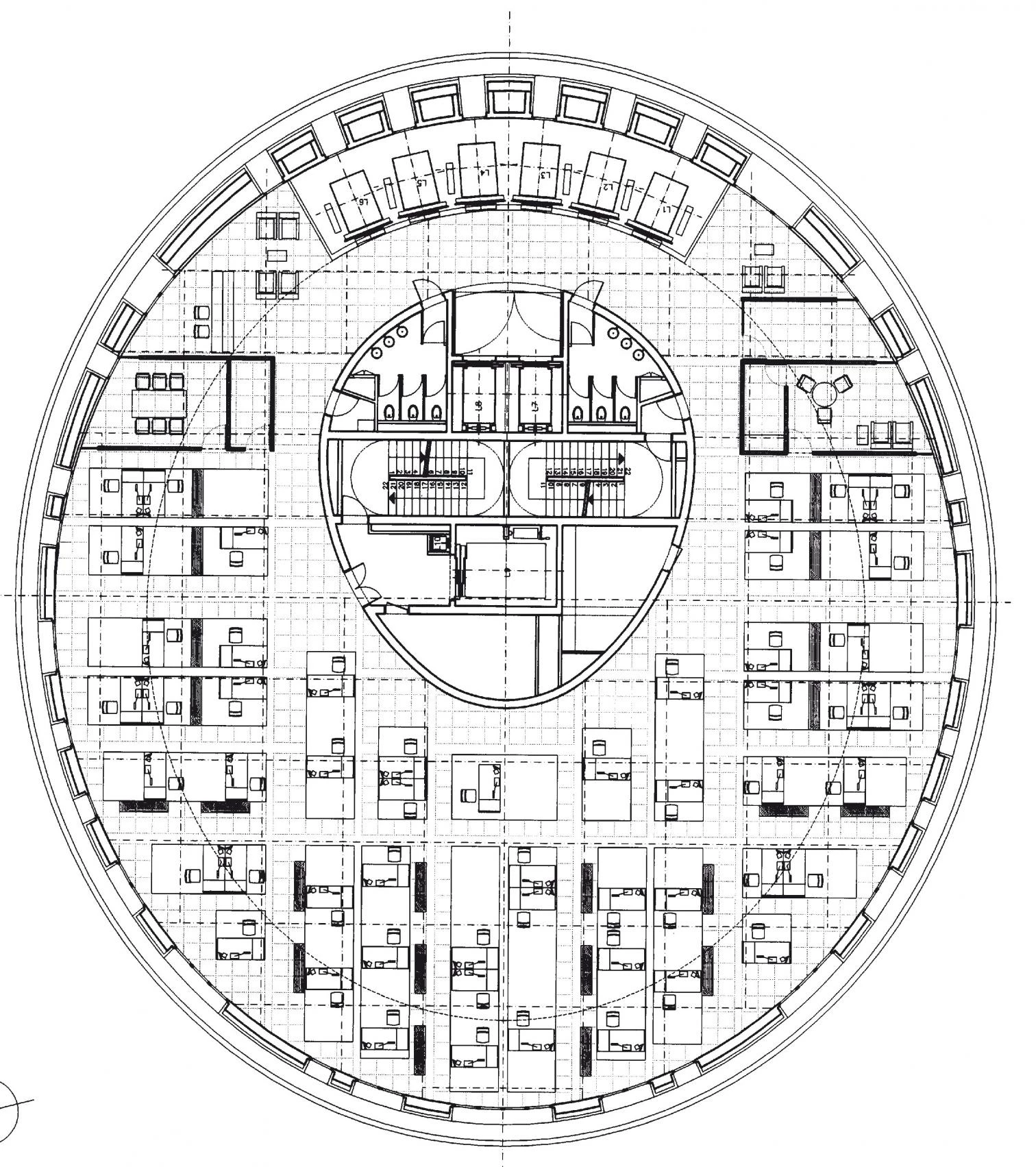
London’s Swiss Re tower is a stretched geodesic bubble, with a floor plan of six petals and courtyards on the facade; and Barcelona’s Agbar tower is a cylindrical bunker, with its backbone in off-center position.
In Swiss Re, every design decision – from the triangulation of the facade to the circulation of air in the diagonal courtyards – seems to be derived from an impeccable structural and functional logic, and the result is an object of rare perfection, posed in the crowded and mediocre heart of London’s financial district like a spacecraft able to transport us to the planet of milk and honey that modernity has so often promised us in vain. In the Agbar tower, in contrast, all design elements – from the aleatory arrangement of openings in the concrete stem to the changing colors of the aluminum panel cladding –could be said to be products of the architect’s intuition, sensibility, or even caprice, and if the shaft currently under construction now shocks for an unexpected hermetism barely alleviated by musical perforations, when the building finally sports its glass skin it will rise in the disorderly context of the Plaza de las Glorias like the immaterial, ghostly and evanescent presence prefigured by its author. Such differences in architectural conception have a bearing on the image of the corporate occupants: the London headquarters is more egalitarian, with its shared bioclimatic terraces and its common greenhouse on top, whereas the Barcelona one is rather more hierarchized, with its transparent dome for top executives crowning the bastion with port-holes for rank and file employees.
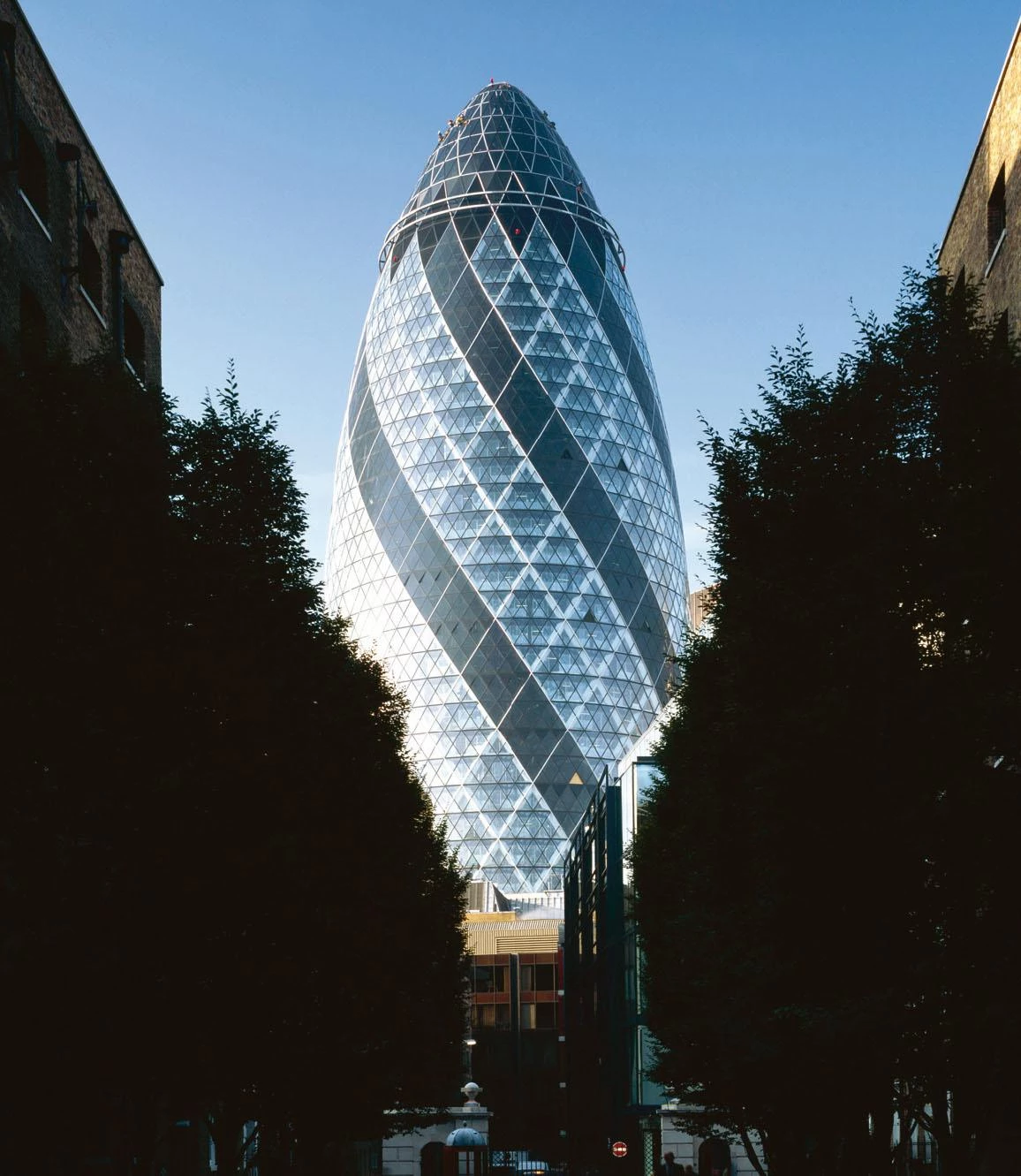
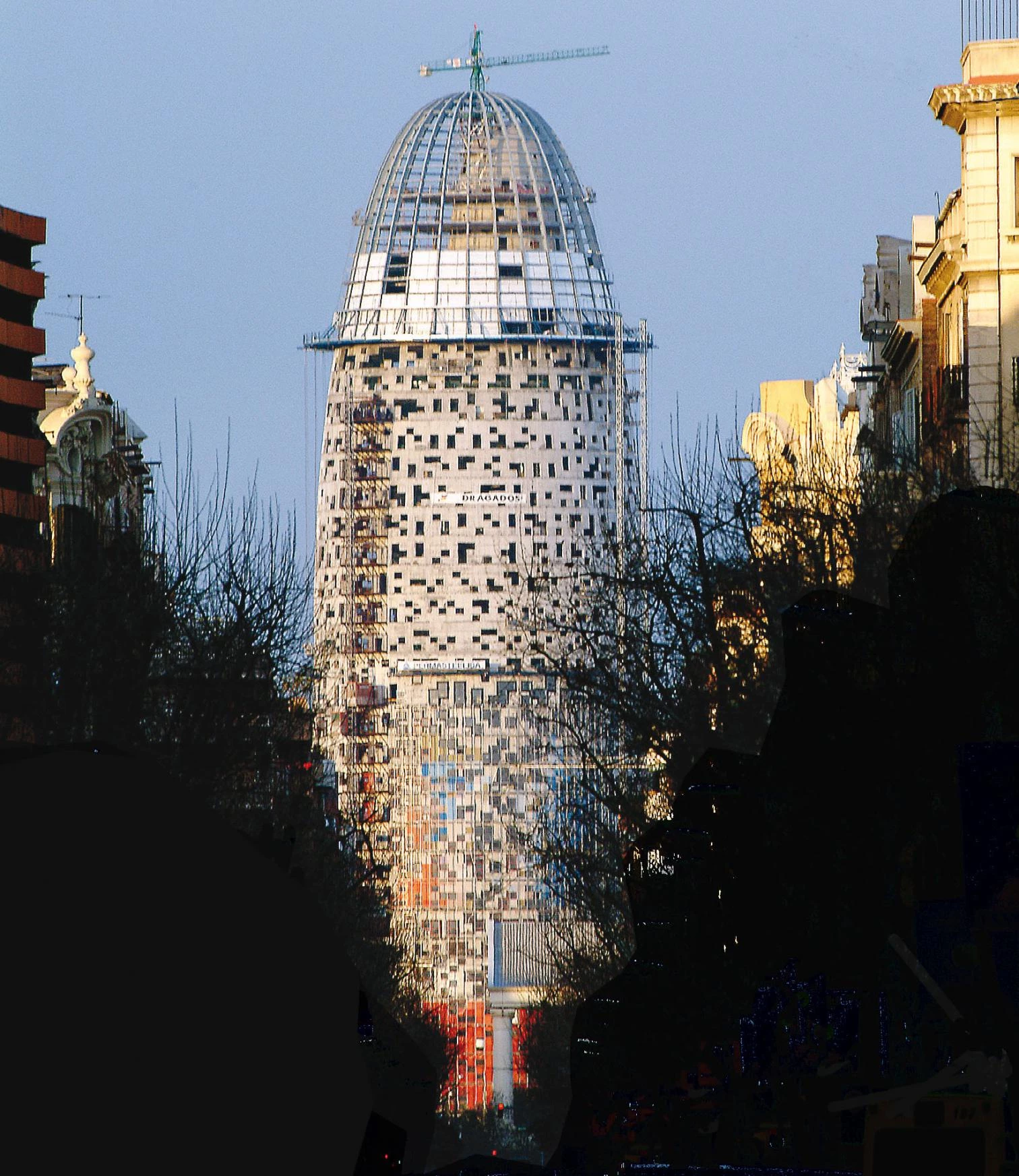
Although the two skyscrapers have similar dimensions and both are in cities with little tradition in or sympathy for high-rise construction, they are destined to differ in their urban impact. Swiss Re soars 40 stories and 180 meters but is flanked by two other rather anonymous towers and stands on the site of a previous skyscraper (the Baltic Exchange, razed after being seriously damaged by an IRA attack in 1992). Because of this, only its peculiar shape will become a topic of discussion, and on this account, both the contrast with its nondescript neighbors and its generous concessions to pedestrians – made possible by its circular floor plan –are sure to guarantee a favorable reception. Agbar, in contrast, rises 32 floors and 142 meters in such splendid isolation that it can only engage in long-distance dialogue with the towers of Gaudí’s Sagrada Familia, and will inevitably become a landmark of singular visibility and symbolic relevance, au-guring the heated polemic that Josep Acebillo has tried to channel by comparing the building to a camel’s hump, which far from being “an ugly and unnecessary bump” makes the animal faster and more resilient (Barcelona’s urban planning chief has perhaps not heard the joke about a camel being a horse designed by a committee... or an architect).

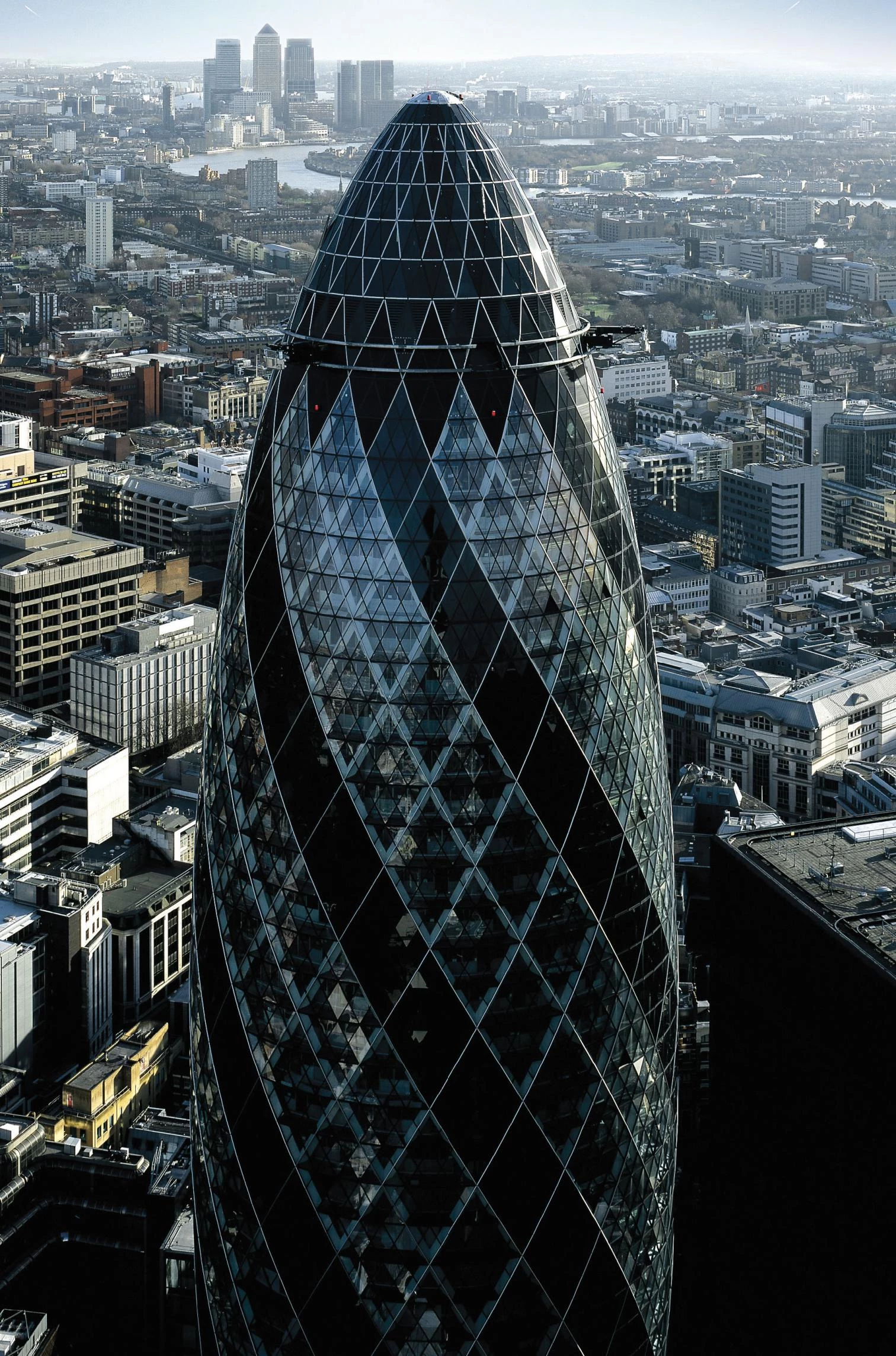
Foster has designed his London skyscraper with a load-bearing and triangulated facade, with steel tubes assembled every two stories and 20º of aperture, giving a light appearance to the City’s high-rise landscape.
Standard or Specific
Both projects have precedents in the previous oeuvre of their authors, but here again there is a divergence, because while the London work basically presents itself as a repeatable prototype in line with modernity’s normalizing and universalist mission, the Barcelona proposal endeavors to come across as a specific building determined by the place and the occasion, in harmony with the emblematic individuality of postmodern objects and languages. In the case of Foster, the elongated spheroid that the media has nicknamed ‘gherkin’comes from his 1971 collaboration with Buckminster Fuller in the design of an integrated work environment, with different platforms in a single space covered by a geodesic dome. Named Climatroffice, it was a futuristic proposal that technical and computer resources have allowed to materialize thirty years later. As for Nouvel, the ovoid and flou menhir that will vanish with the help of a chromatic dermis of reddish or bluish panels and a graphic epidermis of serigraphed or translucent glass pieces has its origins in the ‘Tour sans fin’ that won the 1989 competition (with Foster on the jury, by the way) for a skyscraper beside the Grand Arche of La Défense in Paris, a tower of bold sveltness (1:10) and colossal height (400 meters) whose tip was to fade into the sky, and which was never built; but the Barcelona project puts special emphasis on the fact that the execution in concrete of its cavernous volume responds to the Mediterranean climate and light with thermal inertia and reduced openings, its rounded shape echoes Gaudi’s spires and the winderoded rocks of Montserrat, and its frozen-geyser look can be presumed to be a reference to the water company that is to occupy it, and who knows, maybe even to the Buigas fountains on Montjuïc.

Nouvel has drawn inspiration from Gaudí when proposing for Barcelona a chromatic aluminum and glass skin, offering an evanescent contrast with the tower’s formal boldness, isolated in the Plaza de las Glorias.
Whatever the case, the execution of each glass shell is a formidable technical feat and a unique urban spectacle. In London, the extraordinary precision of the assemblage, using bolts, of the steel tubes that every two stories and 20º of aperture go about triangulating the load-bearing facade is comparable only to the painstaking exactitude of the frames of the enclosure, placed modularly at intervals of 5º, and only the fire-prevention guidelines, which make it compulsory to protect the structure with insulation and a subsequent aluminum shell, somewhat reduce the elegance and lightness of this admirable work. And in Barcelona, the exigent tolerances in the adjustment of the thick concrete wall with the aluminum and glass cladding should put to test the rigorous professionalism of the building’s co-author, b720, a Spanish group headed by the architect Fermín Vázquez (that is also working with Nouvel in Madrid’s Reina Sofía, and with the British David Chipperfield in several Spanish projects). September 11 threw many shadows on the future of skyscrapers, but seems not to have affected these European works. Neither does it seem to have intimidated the architects, Foster included, who have submitted defiant proposals for New York’s Ground Zero, nor those who continue to draw up unique towers for Asia’s Pacific coast, such as the loop-shaped one designed by Rem Koolhaas for Chinese television in Beijing. But today the shadow of the terrorist attacks closes in on other lands, placing different shells on the eve of another Kristallnacht.





